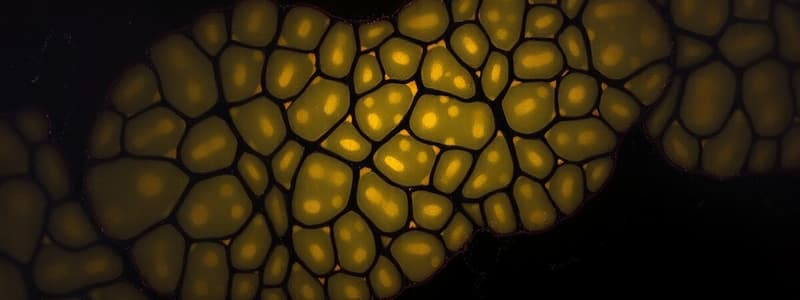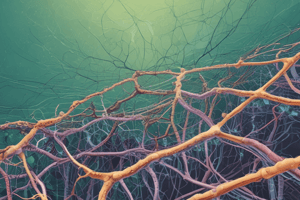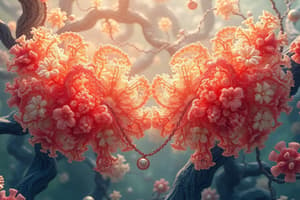Podcast
Questions and Answers
What role do tight junctions play between intestinal cells?
What role do tight junctions play between intestinal cells?
- They act as communication channels between cells.
- They serve as structural support for cells.
- They allow molecules to pass freely between cells.
- They force molecules to pass through epithelial cells. (correct)
What are desmosomes primarily responsible for?
What are desmosomes primarily responsible for?
- Transporting substances between cells.
- Facilitating intercellular communication.
- Increasing the strength of tissues. (correct)
- Sealing gaps between cells.
Which function is associated with gap junctions?
Which function is associated with gap junctions?
- Providing structural support to cell membranes.
- Preventing the passage of ions between cells.
- Facilitating the attachment of cells.
- Allowing small molecules to pass between cells. (correct)
What distinguishes microvilli on epithelial cells?
What distinguishes microvilli on epithelial cells?
Where are desmosomes typically located within cells?
Where are desmosomes typically located within cells?
What structural feature is associated with epithelial cells in kidney tubules?
What structural feature is associated with epithelial cells in kidney tubules?
Which type of tissue is least likely to contain gap junctions?
Which type of tissue is least likely to contain gap junctions?
How do microvilli appear under light microscopy?
How do microvilli appear under light microscopy?
What happens to water molecules when they move into a salt solution?
What happens to water molecules when they move into a salt solution?
What is equivalent to the osmotic pressure of a solution?
What is equivalent to the osmotic pressure of a solution?
How do marine bony fishes maintain their blood solute concentration?
How do marine bony fishes maintain their blood solute concentration?
Which term is sometimes preferred over osmotic pressure due to its potential confusion?
Which term is sometimes preferred over osmotic pressure due to its potential confusion?
What must a solution be separated from to exhibit osmotic pressure?
What must a solution be separated from to exhibit osmotic pressure?
What is the state called when the fluid level in the funnel becomes stationary?
What is the state called when the fluid level in the funnel becomes stationary?
What type of environment is a freshwater stream for a marine bony fish?
What type of environment is a freshwater stream for a marine bony fish?
Why is it essential for cells to allow certain materials in and out despite the cell membrane's barrier?
Why is it essential for cells to allow certain materials in and out despite the cell membrane's barrier?
What is the primary function of the sodium-potassium exchange pump?
What is the primary function of the sodium-potassium exchange pump?
Which of the following statements describes the relationship between sodium and potassium ion concentrations inside and outside the cell?
Which of the following statements describes the relationship between sodium and potassium ion concentrations inside and outside the cell?
Which type of endocytosis is primarily used by white blood cells to engulf microbes?
Which type of endocytosis is primarily used by white blood cells to engulf microbes?
What mechanism does potocytosis utilize for internalization?
What mechanism does potocytosis utilize for internalization?
What percentage of the total energy produced by a cell may be consumed by the sodium-potassium exchange pump?
What percentage of the total energy produced by a cell may be consumed by the sodium-potassium exchange pump?
Which cellular process involves internalizing solid particles?
Which cellular process involves internalizing solid particles?
What role do intracellular enzymes play in phagocytosis?
What role do intracellular enzymes play in phagocytosis?
Which of the following best describes the primary purpose of endocytosis?
Which of the following best describes the primary purpose of endocytosis?
What is the primary product of glycolysis from glucose?
What is the primary product of glycolysis from glucose?
What role does NADH play in cellular respiration?
What role does NADH play in cellular respiration?
How many ATP molecules are produced from one molecule of glucose during glycolysis?
How many ATP molecules are produced from one molecule of glucose during glycolysis?
What happens to the two molecules of pyruvic acid formed in glycolysis under aerobic conditions?
What happens to the two molecules of pyruvic acid formed in glycolysis under aerobic conditions?
What is the initial step of glycolysis involving the phosphorylation of glucose?
What is the initial step of glycolysis involving the phosphorylation of glucose?
What is the net ATP yield from glycolysis after accounting for the initial investment?
What is the net ATP yield from glycolysis after accounting for the initial investment?
During glycolysis, what type of reaction occurs when fructose-1,6-diphosphate is cleaved?
During glycolysis, what type of reaction occurs when fructose-1,6-diphosphate is cleaved?
Which compound accepts electrons at the end of the electron transport chain?
Which compound accepts electrons at the end of the electron transport chain?
How many ATP molecules are yielded from one NADH during oxidative phosphorylation?
How many ATP molecules are yielded from one NADH during oxidative phosphorylation?
What is the process called that couples the formation of high-energy phosphate to oxygen consumption?
What is the process called that couples the formation of high-energy phosphate to oxygen consumption?
What is the maximum net yield of ATP from one molecule of glucose after accounting for glycolysis?
What is the maximum net yield of ATP from one molecule of glucose after accounting for glycolysis?
Which molecule enters the electron transport chain at a lower level, yielding fewer ATP molecules?
Which molecule enters the electron transport chain at a lower level, yielding fewer ATP molecules?
What role do protons play in ATP formation during oxidative phosphorylation?
What role do protons play in ATP formation during oxidative phosphorylation?
How many ATP are produced from each NADH generated in glycolysis, considering the transport cost?
How many ATP are produced from each NADH generated in glycolysis, considering the transport cost?
What is the overall efficiency of aerobic oxidation of glucose?
What is the overall efficiency of aerobic oxidation of glucose?
Which of the following best describes the role of ATP-forming protein complexes?
Which of the following best describes the role of ATP-forming protein complexes?
Study Notes
Cell Junctions
- Tight Junctions: Force molecules absorbed from intestinal content to pass through epithelial cells, ensuring selective permeability.
- Desmosomes: Serve as mechanical "spot-welds" between cells, providing strength without sealing gaps. They are connected by intermediate filaments and linker proteins.
- Gap Junctions: Allow intercellular communication through tiny canals, enabling small molecule passage. Found in epithelial, nervous, and muscle tissues.
- Interdigitating Membranes: Cell membranes fold and intertwine, enhancing adhesion, notably in kidney tubule epithelial cells.
- Microvilli: Finger-like projections on epithelial cells that increase surface area for absorption, forming a brush border visible in light microscopy.
Osmosis and Water Movement
- Water moves from higher concentration (pure water) to lower concentration (salt solution) until equilibrium is reached, creating osmotic pressure countered by hydrostatic pressure.
- Osmotic pressure reflects the pressure needed to prevent water entry due to a selectively permeable membrane.
- The concept of osmotic potential is preferred over osmotic pressure to clarify its contextual meaning, especially relating to biological scenarios.
Active Transport Mechanisms
- Sodium-Potassium Pump: Maintains essential ion gradients; potassium ions are more concentrated inside cells, while sodium ions are higher outside. Up to 40% of cellular energy is expended on this process.
- Active transport is crucial for nutrient uptake and waste removal, affecting overall cell function.
Endocytosis Types
- Phagocytosis: "Cell eating"; a method used by protists and immune cells (like leukocytes) to engulf and digest large particles or microbes.
- Potocytosis: Involves caveolae—small invaginated pits on the cell membrane—internalizing small molecules and ions, with specific receptors aiding in substance uptake.
Glycolysis and Cellular Respiration
- Glycolysis Overview: Converts glucose into pyruvic acid through enzymatic reactions, producing a net gain of two ATP molecules per glucose.
- Energy Yield: Glycolysis oxidizes glucose, producing NADH, which carries electrons to the electron transport chain (ETC) for further ATP synthesis.
- Each molecule of glucose leads to formation of two molecules of pyruvic acid and two NADH through glycolytic pathways.
Acetyl Coenzyme A in Respiration
- Pyruvic acid from glycolysis enters mitochondria, where it is further oxidized to yield additional ATP via the ETC.
- Oxidative Phosphorylation: Involves chemiosmotic coupling, generating ATP as protons flow back across the mitochondrial membrane.
ATP Yield Calculation
- Complete oxidation of glucose can yield a maximum of 36 ATP molecules. Two ATP are consumed initially in glycolysis, leading to a net yield factoring in mitochondrial NADH transport efficiency.
- The overall efficiency of glucose oxidation is about 38%, significantly higher than most artificial energy systems.
Studying That Suits You
Use AI to generate personalized quizzes and flashcards to suit your learning preferences.
Related Documents
Description
This quiz delves into the structure and function of tight junctions between intestinal cells. It explores how these junctions regulate the transport of molecules and the importance of ellipsoid discs in cellular membranes. Test your knowledge on the critical roles these structures play in epithelial cell function.



